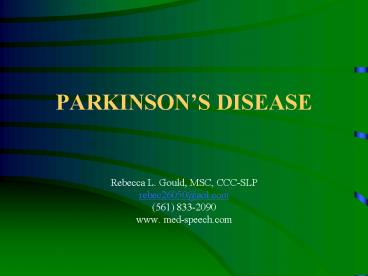PARKINSON - PowerPoint PPT Presentation
1 / 29
Title:
PARKINSON
Description:
swallowing. voice/phonation ' ... SWALLOWING STAGES BY PHASE (cont'd) Oro ... Alternate liquid/dry swallows. Refrain from talking while chewing/swallowing ... – PowerPoint PPT presentation
Number of Views:36
Avg rating:3.0/5.0
Title: PARKINSON
1
PARKINSONS DISEASE
- Rebecca L. Gould, MSC, CCC-SLP
- rebec26050_at_aol.com
- (561) 833-2090
- www. med-speech.com
2
Parkinsons Disease impacts voice and swallowing
- WHY?
3
THE LARYNX
4
Functions of the Larynxbreathingthoracic
fixationcoughingswallowingvoice/phonation
5
- More than 15 million Americans have some degree
of dysphagia, and with regular treatment 83
recover or significantly improve. - Bello, J. (1994) compiled by Communication
Facts. ASHA Research Division - RLG
6
SWALLOWING STAGES BY PHASE
- Oral Phase
- Food enters oral cavity
- Mastication and bolus formation
- RLG
7
SWALLOWING STAGES BY PHASE (contd)
- Oro-pharyngeal Phase
- Tongue elevates and propels bolus to pharynx.
- Soft palate elevates to seal nasopharynx.
- Larynx and hyoid bone move anterior and upward.
- Epiglottis moves posteriorly and downwards to
close. - Respiration stops.
- Pharynx shortens. RLG
8
SWALLOWING STAGES BY PHASE (contd)
- Esophageal Phase
- Upper esophageal sphincter relaxes.
- Bolus passes to esophagus.
- Esophageal contracts sequentially.
- Lower esophageal sphincter relaxes.
- Bolus reaches stomach.
-
RLG
9
- Radical dietary changes and artificial feeding
are drastic measures by any standards. - M.J. Feinberg, MD (1990)
-
RLG
10
RESIDUAL
- Leftover material in the oral pharynx after
swallow has occurred.
11
PENETRATION
- Entry of material into the laryngeal vestibule
to the level of the vocal folds.
12
ASPIRATION
- Entry of material below the level of true vocal
folds.
13
Incidence and patient characteristics associated
with silent aspiration in the acute care setting
- Coughing is a physiologic response to aspiration
in normal healthy individuals. No cough in
response to aspiration silent aspiration - Smith, C.H. et al (1999)
14
- Gurgly vocal quality predictive of who will
aspirate on VFSS - Linden (1993)
15
SCALE PREDICTIVENESS OF PNEUMONIA RISK IF FED
- FACTORS
- Multiple or progressive disease/one diagnosis
- Multiple medications (gt5)/ lt5 medications
- NPO (PEG)/ oral
- Oral hygiene fair poor/ good excellent
- Smoker / non-smoker
- RLG
16
SCALE PREDICTIVENESS OF PNEUMONIA RISK IF FED
(contd)
- FACTORS
- Inpatient / outpatient
- Physical ability (mobile)/ sedentary
- Reflexive cough (present) / absent delayed
- Cognitive status (fair-poor)/ good excellent
- Secretion Pooling (minimal) / copious
- RLG
17
SCALE PREDICTIVENESS OF PNEUMONIA RISK IF FED
(contd)
- Score
- lt 7 Use extreme caution
- 56 fair good
- lt3 good excellent
- RLG
18
General Postural/ Feeding Instructions
- Upright, 90 degree position
- Concentrate on each swallow
- Take full tsp.
- Pause between bites/sips
19
General Postural/ Feeding Instructions (contd)
- Alternate liquid/dry swallows
- Refrain from talking while chewing/swallowing
- Chew each bite thoroughly
- Hold breath, swallow high and hard, swallow again
20
(No Transcript)
21
COMMUNICATION
- MUTUAL UNDERSTANDING OF SHARED INFORMATION
22
Relative vocal loudness level of an individual
with Parkinsons Disease
- Shout
- Loud
- Normal loudness
- Soft
- Very soft
- Vocal loudness level of an individual with
Parkinsons Disease
23
THINK LOUD!
24
THINK BREATHE!
25
Conversational Strategies Checklist
- Gain eye contact with your communication partner
before speaking. - Avoid speaking when you are tired.
- Speak in a quiet environment.
- Take your time while speaking.
- Exaggerate your articulatory movements.
26
Conversational Strategies Checklist (contd)
- Speak louder.
- Take natural pauses while speaking.
- Keep your face free from distractions.
- Use body language to convey turn taking.
- Allow yourself time for a conversation.
- Avoid repeating words and phrases.
- Use body language to convey turn taking.
27
Conversational Strategies Checklist (contd)
- Rephrase your message if your communication
partner does not understand you. - Use an alternative system to communicate if your
speech is difficult to understand. - Appreciate your communication partners efforts.
- Be patient with yourself.
28
THERAPY
- The human body is one of the greatest
compensatory mechanisms. - RLG
29
(No Transcript)































